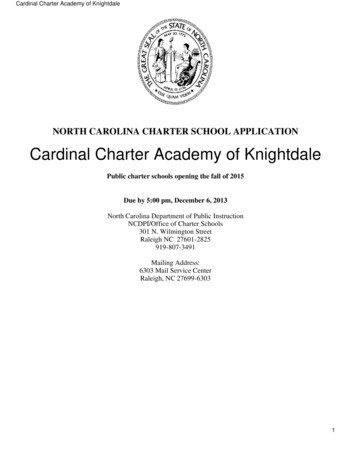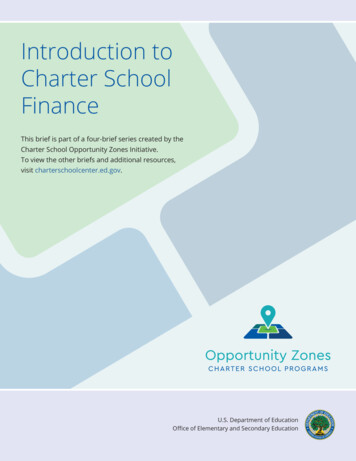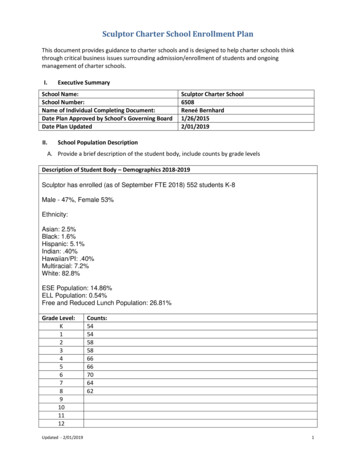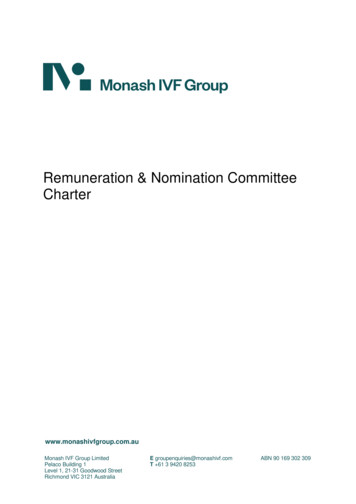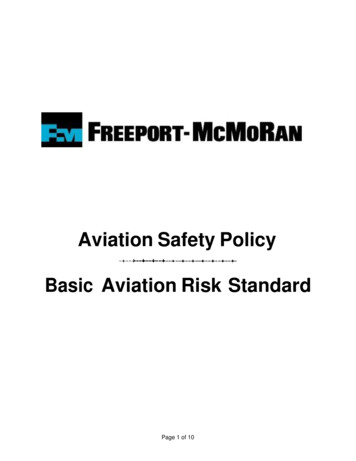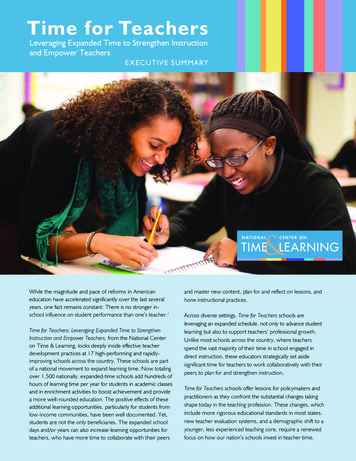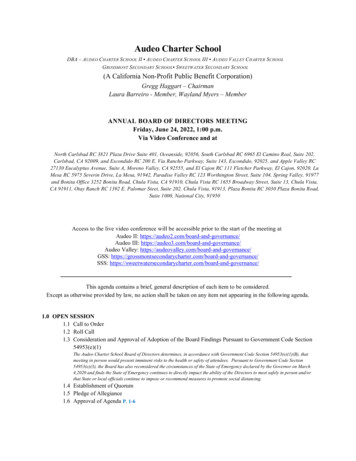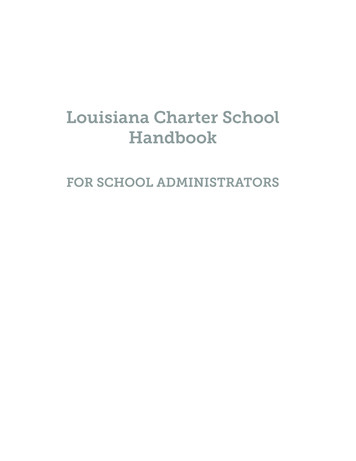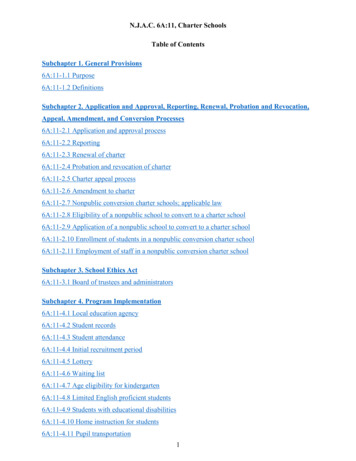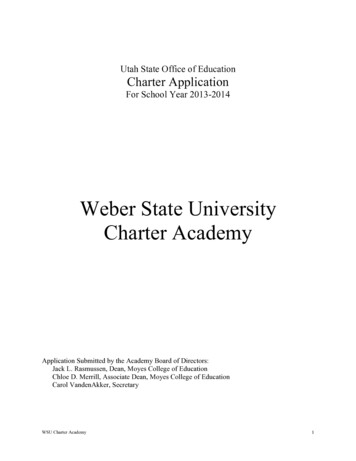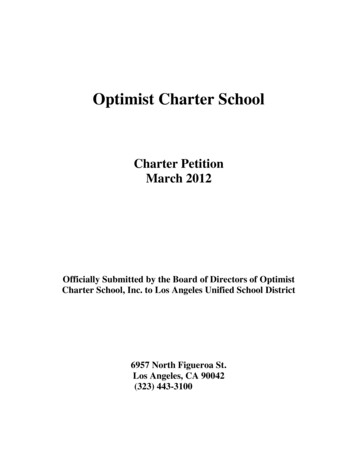
Transcription
Charter Renewal PetitionChildren’s Community CharterSchool21st Century LearnersSubmitted to Paradise Unified School DistrictCharter Renewal Term: July 1, 2020 – June 30, 2025
Table of .XIV.XV.XVI.XVII.XVIII.IntroductionAffirmations and AssurancesElement 1: Educational ProgramElement 2: Measurable Student OutcomesElement 3: Method of AssessmentElement 4: Governance StructureElement 5: Employee QualificationsElement 6: Health and Safety ProceduresElement 7: Student Population BalanceElement 8: Admission Policies and ProceduresElement 9: Financial AuditsElement 10: Pupil Suspension and ExpulsionElement 11: Employee Retirement SystemsElement 12: Public School Attendance AlternativesElement 13: Employee Return RightsElement 14: Dispute Resolution ProceduresElement 15: School ClosureMiscellaneous Charter ProvisionsAppendicesAppendix A: CDE DataQuest/CAASPP ReportsAppendix B: 2019-2020 LCAPAppendix C: Memorandum of UnderstandingAppendix D: CCCS Articles of Incorporation and Governing Board BylawsAppendix E: Pupil Suspension & Expulsion PolicyAppendix F: 5-Year Budget 2 57
I.IntroductionBackgroundEstablished in 1996, Children’s Community Charter (“CCCS” or the “Charter School”),commonly known as Children’s Community Charter School, is a direct-funded California publiccharter school. CCCS has established itself as one of the leading TK-8 schools in NorthernCalifornia and statewide. CCCS was founded as a partnership between staff and parents. Thecurrent academic program, one that stresses exploration and hands-on learning coupled with parentparticipation, has resulted in a school culture with elevated academic, social, and professionalexpectations. Our stakeholder family of students, staff, parents, and community supporters hasallowed CCCS to achieve sustainability and continuity despite uncertain budget times.Our current enrollment is now 75 students, with approximately 320 openings.Mission, Vision, and ValuesOur Mission: To ensure high levels of learning for ALL students. We are committed to academic,behavioral, and social/emotional learning to benefit the whole child.Our Vision: Fostering a deep partnership with families, every student will be college or careerready through a rigorous academic program delivered in an environment of support,understanding, and emotional safety. Our students are and will continue to be resilient, empathetic,and prepared for life.Core Values: Collaboration Growth Mindset Life-long learning Interdependency Accountability EmpathyCharter Renewal: Intent of the Charter Schools Act of 1992In accordance with Education Code Section 47600 et. seq., CCCS petitions the Paradise UnifiedSchool District (“PUSD” or the “District”) for renewal of the CCCS charter for a term of five yearsfrom July 1, 2020 to June 30, 2025.Education Code Section 47601 codifies the legislative intent behind the Charter Schools Act of1992. It states as follows:“It is the intent of the Legislature in enacting this part to provide opportunities forteachers, parents, pupils, and community members to establish and maintain schools thatoperate independently from the existing school district structure, as a method toaccomplish all of the following: 3
(a) Improve pupil learning.(b) Increase learning opportunities for all pupils, with special emphasis on expandedlearning experiences for pupils who are identified as academically low achieving.(c) Encourage the use of different and innovative teaching methods.(d) Create new professional opportunities for teachers, including the opportunity to beresponsible for the learning program at the schoolsite.(e) Provide parents and pupils with expanded choices in the types of educationalopportunities that are available within the public school system.(f) Hold the schools established under this part accountable for meeting measurablepupil outcomes, and provide the schools with a method to change from rule-basedto performance-based accountability systems.(g) Provide vigorous competition within the public school system to stimulate continualimprovements in all public schools.”By offering a small school option centered on 21st Century Learning skills and parent participation,CCCS makes important contributions to the legislative goals outlined above. Thus, by approvingthis charter school renewal petition, PUSD will help to fulfill the intent of the legislature.Charter Renewal CriteriaEvidence of Meeting Charter Renewal Standards Pursuant to Education Code Section 47607(b)and the California Code of Regulations, Title 5, Section 11966.4(b)(1)Charter petitions must satisfy at least three requirements to be renewed:1. Education Code Section 47607(a)(3)(A) states: “The authority that granted the charter shallconsider increases in pupil academic achievement for all groups of pupils served by thecharter school as the most important factor in determining whether to grant a charterrenewal.”Such increases are documented below.AND2. Education Code Section 52052(f) states: “For purposes of paragraphs (1) to (3), inclusive,of subdivision (b) of Section 47607, alternative measures that show increases in pupilacademic achievement for all groups of pupils schoolwide and among numericallysignificant pupil subgroups shall be used.”The alternative measures that show increases at the Charter School are documented below.OR3. Education Code Section 47607(b)(4) states: “The entity that granted the charter determinesthat the academic performance of the charter school is at least equal to the academic 4
performance of the public schools that the charter school pupils would otherwise have beenrequired to attend, as well as the academic performance of the schools in the school districtin which the charter school is located, taking into account the composition of the pupilpopulation that is served at the charter school.”This determination, which requires a comparison to other public schools, is documentedbelow.AND4. Title 5, California Code of Regulations Section 11966.4(b)(1) states: “When considering apetition for renewal, the district board of education shall consider the past performance ofthe school's academics, finances, and operation in evaluating the likelihood of futuresuccess, along with future plans for improvement, if any.”This requirement is met through the documentation presented in the charter renewalpetition and appendices.The following shall serve as documentation confirming that the Charter School meets the statutorycriteria required for renewal as set forth in Education Code Sections 47607(a)(3)(A), 52052(f), and47607(b)(4) (Also see Appendix A: CDE DataQuest/CAASPP Reports):Analysis of Children’s Community Charter School Alternative Measures Data (EducationCode Section 52052(f))Children’s Community Charter School California Assessment of Student Performance andProgress (“CAASPP”) Scores, 2015-2019: Percentage of Students Meeting or .03%CCCS is proud that our schoolwide and subgroup CAASPP scores show improvement each year.Analysis of Comparison Schools Data (Education Code Section 47607(b)(4))Comparison Schools That Children’s Community Charter School Students Would Otherwise BeRequired to 4.70%52.94% 5
CedarwoodElementaryParadiseElementaryPine arison Schools That Are Demographically Similar in the ntaryPine 0.62%25.71%56.25%64.70%52.94%NANANANANA64.70% 6
II.Affirmations and DeclarationAs the authorized lead petitioner, I, Michelle Farrer, hereby certify that the information submittedin this petition for the renewal of a California public charter school named Children’s CommunityCharter, located within the boundaries of Paradise Unified School District, is true to the best ofmy knowledge and belief; I also certify that this petition for renewal does not constitute theconversion of a private school to the status of a public charter school; and, further, I understandthat if awarded a renewal of the charter, CCCS will follow any and all federal, state, and local lawsand regulations that apply to the Charter School, including but not limited to: The Charter School shall meet all statewide standards and conduct the student assessmentsrequired, pursuant to Education Code Section 60605, and any other statewide standardsauthorized in statute, or student assessments applicable to students in non-charter publicschools. (Ref. Education Code Section 47605(d)(1)) The Charter School declares that it shall be deemed the exclusive public school employerof the employees of CCCS for purposes of the Educational Employment Relations Act.(Ref. Education Code Section 47605(c)(6)) The Charter School shall be non-sectarian in its programs, admissions policies,employment practices, and all other operations. (Ref. Education Code Section 47605(e)(1)) The Charter School shall not charge tuition. (Ref. Education Code Section 47605(e)(1)) The Charter School will admit all students who wish to attend the Charter School unlessthe Charter School receives a greater number of applications than there are spaces forstudents, in which case it will hold a random drawing to determine admission. Except asrequired by Education Code Section 47605(e)(2), admission to CCCS shall not bedetermined according to the place of residence of the student or of that student’s parent orlegal guardian within the State. Preference in the public random drawing shall be given asrequired by Education Code Section 47605(e)(2)(B)(i)-(iv). In the event of a drawing, thechartering authority shall make reasonable efforts to accommodate the growth of CCCS inaccordance with Education Code Section 47605(e)(2)(C). (Ref. Education Code Section47605(e)(2)(A)-(C)) The Charter School shall not discriminate on the basis of the characteristics listed inEducation Code Section 220 (actual or perceived disability, gender, gender identity, genderexpression, nationality, race or ethnicity, religion, sexual orientation, or any othercharacteristic that is contained in the definition of hate crimes set forth in Section 422.55of the Penal Code, including immigration status, or association with an individual who hasany of the aforementioned characteristics). (Ref. Education Code Section 47605(e)(1)) The Charter School shall adhere to all provisions of federal law related to students withdisabilities, including, but not limited to, Section 504 of the Rehabilitation Act of 1973,Title II of the Americans with Disabilities Act of 1990, and the Individuals with DisabilitiesEducation Improvement Act of 2004. 7
The Charter School shall meet all requirements for employment set forth in applicableprovisions of law, including, but not limited to credentials, as necessary. (Ref. Title 5California Code of Regulations Section 11967.5.1(f)(5)(C)) The Charter School shall ensure that all core teachers in the charter school hold theCommission on Teacher Credentialing certificate, permit, or document required for theteachers certificated assignment. The Charter School may use local assignment optionsauthorized in statute and regulations for the purpose of legally assigning certificatedteachers, in the same manner as a governing board of a school district. Teachers employedby charter schools during the 2019–20 school year shall have until July 1, 2025, to obtainthe certificate required for the teacher’s certificated assignment (Ref. Education CodeSections 47605(l) and 47605.4(a)) The Charter School shall at all times maintain all necessary and appropriate insurancecoverage. The Charter School shall, for each fiscal year, offer, at a minimum, the number of minutesof instruction per grade level as required by Education Code Section 47612.5(a)(1)(A)-(D). If a pupil is expelled or leaves the Charter School without graduating or completing theschool year for any reason, the Charter School shall notify the superintendent of the schooldistrict of the pupil’s last known address within 30 days, and shall, upon request, providethat school district with a copy of the cumulative record of the pupil, including report cardsor a transcript of grades, and health information. If the pupil is subsequently expelled orleaves the school district without graduating or completing the school year for any reason,the school district shall provide this information to the Charter School within 30 days if theCharter School demonstrates that the pupil had been enrolled in the Charter School. (Ref.Education Code Section 47605(e)(3)) The Charter School may encourage parental involvement, but shall notify the parents andguardians of applicant pupils and currently enrolled pupils that parental involvement is nota requirement for acceptance to, or continued enrollment at, the Charter School. [Ref.Education Code Section 47605(n)] The Charter School shall maintain accurate and contemporaneous written records thatdocument all pupil attendance and make these records available for audit and inspection.(Ref. Education Code Section 47612.5(a)(2)) The Charter School shall, on a regular basis, consult with its parents and teachers regardingthe Charter School's educational programs. (Ref. Education Code Section 47605(d)) The Charter School shall comply with any applicable jurisdictional limitations to thelocations of its facilities. (Ref. Education Code Sections 47605 and 47605.1) The Charter School shall comply with all laws establishing the minimum and maximumage for public school enrollment. (Ref. Education Code Sections 47612(b) and 47610) 8
The Charter School shall comply with all applicable portions of the Elementary andSecondary Education Act (“ESEA”), as reauthorized and amended by the Every StudentSucceeds Act (“ESSA”). The Charter School shall comply with the Public Records Act. The Charter School shall comply with the Family Educational Rights and Privacy Act. The Charter School shall comply with the Ralph M. Brown Act. The Charter School shall comply with Government Code Section 1090, et seq., as set forthin Education Code Section 47604.1. The Charter School shall comply with the Political Reform Act. The Charter School shall meet or exceed the legally required minimum number of schooldays. [Ref. Title 5 California Code of Regulations Section 11960] 9
III.Element 1: Educational ProgramThe educational program of the charter school, designed, among other things, to identify those whom the charterschool is attempting to educate, what it means to be an “educated person” in the 21st century, and how learningbest occurs. The goals identified in the program must include the objective of enabling pupils to become selfmotivated, competent, and lifelong learners.Education Code Section 47605(c)(5)(A)(i)The annual goals for the charter school for all pupils and for each subgroup of pupils identified pursuant to Section52052, to be achieved in the state priorities, as described in subdivision (d) of Section 52060, that apply for thegrade levels served and specific annual actions to achieve those goals. A charter petition may identify additionalschool priorities, the goals for the school priorities, and the specific annual actions to achieve those goals.Education Code Section 47605(c)(5)(A)(ii)Overview of ProgramChildren’s Community Charter School serves its students and community to support a ‘21stCentury Learners’ model of education. The Charter School provides a positive, student-centeredenvironment in which all students are actively demonstrating the skills and attitudes gained whileat CCCS. The Charter School’s goal is for students to be productive, globally aware, life-longresponsible learners with the ability to flourish in an increasingly diverse society.As is the strong case with all facets of the 21st Century model, staff development, collaboration,and a strong sense of collegiality with educational professionals is central to CCCS’ success. The‘gift of time’ built into our weekly schedule is unassailable and serves as the bedrock for ourstudents’ ultimate successes.In addition, CCCS strives to entrust children as authorities of their own education and to developa passion for learning. A fundamental goal is to provide a strong foundation in basic academicskills and content knowledge. It is also the Charter School’s goal to develop students’ abilities togather, analyze and use information, solve problems, work cooperatively, think creatively, initiateaction and participate in and contribute to a global society. It is CCCS’ belief that a solidbackground in STEAM skills, in addition to literacy and cultural awareness, will enable its studentsto be college and career ready in the 21st century.Every effort is made to maintain small class sizes. Flexible learning groups are used to meetstudents’ academic needs.The school year calendar follows the traditional calendar. Changes may be made to suit student,facility, and/or teacher and parent needs.The school calendar consists of at least the minimum required annual instructional minutespursuant to Education Code Section 47612.5. This may increase according to student, teacher,parent, and facility needs. 10
Who We Will EducateChildren’s Community Charter School serves all students who desire a quality, comprehensiveacademic program based on a 21st Century Learners model. All students, regardless of ability,socio-economic status, race, creed, color, disability, or sexual orientation and all legally protectedclasses, are given equal opportunity to attend CCCS. Further, CCCS encourages and welcomesacademically ‘at promise’ students to apply for the program.21st Century LearnerCCCS implements the Common Core State Standards (“CCSS”), Next Generation ScienceStandards (“NGSS”), History-Social Science Framework, English Language Development(“ELD”) Standards, and the remaining State Content Standards (collectively referred to herein asthe “State Standards”). The further development and emphasis on all CCCS students’ as 21stCentury Learners are reflected through the following overarching themes that are articulatedthroughout all TK-8 grade levels:A. Core Subjects serve as the main academic tenets of our instructional program. Theseprimary areas of focus include the following:1. Language Arts –The Charter School utilizes instruction based on the Common CoreState Standards. The language arts program at CCCS provides a rich, meaningcentered curriculum that allows students the ability to critically reflect, problem solve,and to bridge the gap from the abstract to the real within the context of their own lives.With the increased emphasis on global communications, students are required to takea more active role as effective communicators. Digital media are among the manyvehicles available for our students to enhance their skills.2. Mathematics – The Charter School utilizes instruction based on the Common CoreState Standards. Rather than emphasizing rote memorization, mathematics instructionfocuses on mathematical reasoning and problem-solving. The use of realia, currentevents, real-world math situations, performance-on-demand, and problem-basedlearning promotes student interest, motivation, and greater subsequent achievement.These serve as the foundational components of CCCS’ mathematics program.3. Science and Engineering –The Charter School has fully implemented NGSS standardsin all K-8 classrooms. The scientific method and inquiry-based teaching practices thatallow students to act as independent learners are key components of the program. Thewealth of computer-based relevant and timely information, coupled with scientificmodeling and simulations, provide 21st Century Learners with a robust and challengingcontent area; a critical need for our nation to develop the next generation of scientistsand researchers must begin to be addressed at the TK-8 level of education. Engineeringconcepts are introduced as early as transitional kindergarten in conjunction with sciencein order to instill innovation and creativity.4. Global Awareness and Social Science – With the dynamic nature of media and 11
technology, nations and cultures across the planet are able to correspond with, andbetter understand, one another. Each nation’s actions have a potential impact on anynumber of others’, lending rise to the imperative that our future leaders develop culturalliteracy and a global awareness along with the requisite training in the more traditionalaspects of social science.5. Financial & Entrepreneurial Literacy – 21st Century Learners must be able tograpple with the new reality of a more global economy. Supply and demand,competition from other nations, and a world-wide pool of qualified applicants forprofessional employment positions requires a deeper understanding of the forcesinvolved with our economy and the global marketplace.6. The Arts – In schools with strong climates, both teachers and students benefit.Teachers have found students who had received high levels of arts training to be morecooperative and more willing to share what they had learned than students with lowlevels of arts training. “High-arts” students are better able to express their ideas, usetheir imaginations and take risks in learning, as reported by teachers (Fiske, 1999). TheCharter School proudly supports Visual and Performing Arts (“VAPA”) as an integralpart of educating students.7. Health and Physical Education - The health and physical education curriculum helpsstudents know and practice good health habits. A foundation of movement experiencesthrough physical education leads to an active and healthy lifestyle. The curriculum isdesigned to meet the individual physical needs of all students. The curriculum is usedto build social skills, self-esteem, cardiovascular development and physical coordination.B. Learning and Innovation Skills that are an expected outcome of all students include thefollowing:1. Creativity – Project-based learning maintains a focus on thinking creatively both‘inside the box’ given established parameters, as well as ‘outside the box’ whengiven full creative license. Students will feel safe when attempting to go beyond the‘easily imagined’ and develop a product or process that pushes their creativeimagination to new heights.2. Innovation –CCCS creates an academic environment that establishes its educatorsas being patient, open to new ideas, nurturing, and wholly supportive of students sothat students will feel encouraged and empowered in taking academic risks.Students are encouraged to demonstrate their own innovative thinking whileauthenticating their mastery of the curriculum presented.3. Critical Thinking – High-order thinking skills are maintained as a fundamentalaspect of classroom instruction. Staff seek to consciously address content by going‘beyond the basics’ of a knowledge and comprehension level. Students are expectedto apply new-found knowledge, as well as to potentially restructure, analyze, andevaluate the result. Inquiry-based lessons through science shift the locus of controlonto the students, as it requires students to formulate a hypothesis, accurately 12
analyze baseline data, synthesize additional data, and to evaluate their initialhypothesis versus quantified results.4. Critical Reflection and Analysis – Students are educated through a comprehensiveprogram steeped in inquiry-based methods that span the entire curricular spectrum.Science content sees students develop hypotheses, analyze results, and criticallyexamine their initial assumptions and relevant data.5. Metacognition – Students are expected to continually reflect on their own learning.“How did I just learn that?” and “What works best for me in order to learn best?”are the key focus questions students are expected to reflect on.6. Community Service – Students are active participants in the Paradise communityand are service oriented. All students are expected to participate in some sort ofcommunity service project each year to give back to the community.C. Information, Media, and Technology Skills are critical for students to master in order tomeet the changes inherent in an increasingly digital society. CCCS looks to increase its useof technology and strives to establish itself as a learning environment that stronglyemphasizes technology in all facets of teaching and learning. Through targeted, ongoingstaff development and training, as well as through hard/software advancements, CCCSshall endeavor to advance to the next level over the course of this renewal term.In order to actively engage students through all facets of its instructional program, CCCS willstrive to offer students the following 21st Century Learning opportunities and activities intechnology:1. Technology Standards have been developed, with each student expected to showmastery of all identified technology standards prior to promoting to high school.Corresponding benchmarks detail what specific skills are inherent within theparticular standard and will include rubrics aligned to success indicators forstudents to aspire to.2. Technology Portfolios are a component of the middle-school program. Studentskeep electronic portfolios of their media-based work and are expected todemonstrate evidence of personal achievement through technological means.3. Media Literacy Skills require students to distinguish between the correct use andselection of the appropriate media for a given purpose. Accurately choosing theproper medium for a given topic or project allows students the opportunity to gainknowledge and use of graphics, print medium, animations, audio, video, Webmedium, and social networking sites.As a result of a media literacy and technology focus, students should be able to:Analyze Media 13
Understanding both how and why media messages are constructed, and for what purposes Examine how individuals interpret messages differently, how values and points of view areincluded or excluded and how media can influence beliefs and behaviors Apply a fundamental understanding of the ethical and legal issues surrounding the accessand use of mediaCreate Media Products Understand and utilize the most appropriate media creation tools, characteristics andconventions Understand and effectively utilize the most appropriate expressions and interpretations indiverse, multi-cultural environments.Apply Technology Effectively Use technology as a tool to research, organize, evaluate and communicate information Use digital technologies (computers, PDAs, media players, GPS, etc.),communication/networking tools and social networks appropriately to access, manage,integrate, evaluate, and create information in order to successfully function in aknowledge economy Apply a fundamental understanding of the ethical/legal issues surrounding the access anduse of information technologiesD. Life and Career Skills focus on the following ‘Great 8’ skills required of all 21st CenturyLearners:1. Initiative – Students are encouraged to be calculated risk-takers as students,whereby the expectation of all staff and students will be a positive ‘whatever ittakes’ approach to being a successful 21st Century Learner. Students in the middlegrades are trained to perform continual self-analysis and to make appropriatepersonal academic adjustments in order to achieve mastery.2. Self-Direction - Students are refocused/redirected whenever appropriate in orderto maintain the locus of control as being with the students themselves. Parentsupport is critical when maintaining a balance between maintenance of a nurturing,positive environment and the critical need for students to be autonomous, explorersof their academic surroundings.3. Ownership – Students are an integral part of the planning and implementation ofthe program focus proposed in this charter. Students are asked to take the leadwhenever appropriate and suitable, based on the specific desired outcome. A CCCSeducation must not be something that a student perceives as ‘happening to them’;rather, it is through and with the student that a powerful educational experience is 14
created.4. Responsibility – Students are expected, ultimately, to be responsible for their ownacademic behaviors. Time management, staying on-task, completing service hours,and being a meta-cognitively aware learner comprise some of the core values andexpectations of CCCS students.5. Marketability – CCCS students will soon be entering a globally competitiveenvironment; this even beginning at the university level, as foreign studentscomprise an increasingly larger percentage of our domestic university population.In order to remain relevant and marketable, CCCS learners must achieve a wellbalanced education, one that is earmarked by an open-mindedness, a willingness tolearn and unlearn new and existing skills, and maintaining the outlook of being alife-long learner.6. Leadership – Students function in a variety of leadership roles at CCCS, both inthe classroom as well as in the greater school community. Project-based learningopportunities are structured to allow each student to take a leadership role in somecapacity. Leadership outcomes are based on the premise that each student’scontribution is equally valid and critical toward the construction of the desiredoutcome objectives.7. Professionalism – Students are expected to develop an
The Charter School shall be nonsectarian in its programs, - admissions policies, employment practices, and all other operations. ( Ref. Education Code Section 47605( e)(1)) The Charter School shall not charge tuition. (Ref. Education Code Section 47605(e)(1)) The Charter School will admit all students who wish to attend the Charter School .
